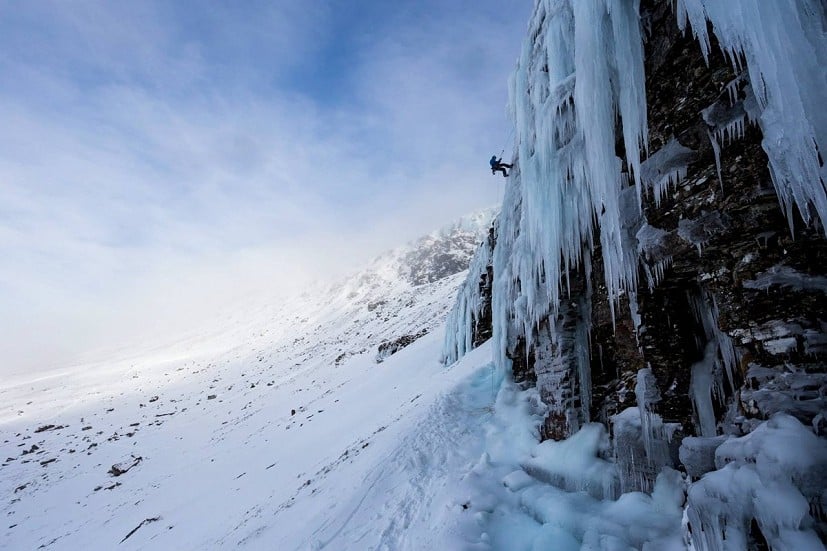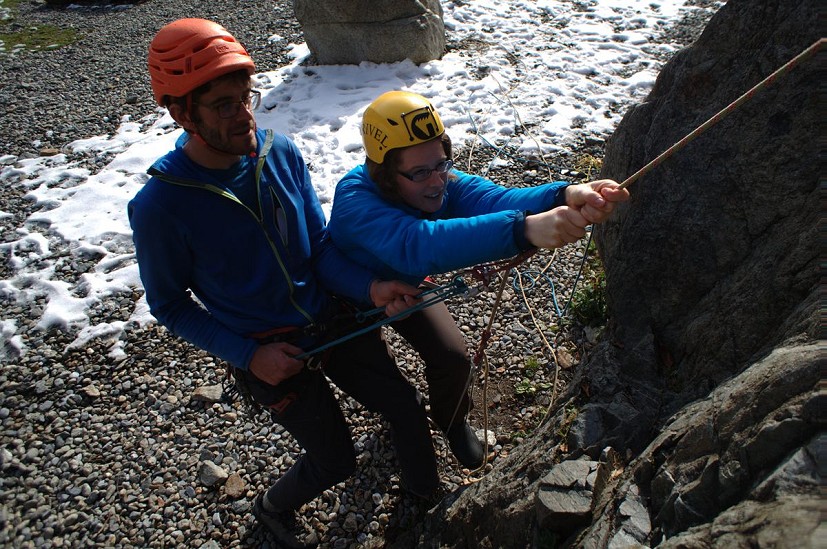Problem Solving when Abseiling
You've been out all day trying that hard route that you've been building up to, and despite your best efforts the top pitch isn't going to go. You are cold, tired, and hungry, it's going dark and to top things off the next storm is starting to roll in. It's time to retreat, so you decide to abseil back down to the ground. Ropes getting stuck can happen at any time when abseiling, but it's in the above scenario that they cause the most discomfort, having proved to be very memorable for both me and my partners.
Knowing how to avoid getting your ropes stuck, and how to deal with it when they do, is an important skill. This article gives some pointers to follow when abseiling to keep ropes pulling smoothly. I also discuss techniques that can be used to retrieve stuck ropes. As always when climbing, it's important to carefully consider actions before taking them. If you aren't sure how to do the things described below and are doing the type of multi-pitch abseiling where this might be necessary, then consider hiring an instructor or taking a course to learn the relevant skills. Similarly, learning to prusik in the dark during a storm is a recipe for disaster - practise these basic techniques in a safe environment before heading into the bigger mountains.
Prevention is better than cure
Retrieving a stuck rope when abseiling can be difficult, time consuming and not completely free of risk. By paying attention to the points below it is possible to reduce the chances of ropes getting stuck:
Check for hang-ups when abseiling
As you abseil down the face, look for places where the knots could get caught as they are pulled down during retrieval, such as flakes of rock, cracks, spikes or constrictions between boulders. Try and route the ropes so that they do not run over or through such sections of rock, if necessary flicking the ropes away from these areas before pulling.
The test pull
If you are unsure whether the abseil ropes are going to pull because you think the ground or anchor is creating a lot of friction, then get the first person down to do a quick test pull. After they have clipped into the next anchor and removed their belay plate and prusik loop, the first climber pulls on the retrieving rope. If it moves then no problem, the second climber can descend to the first. If the ropes don't budge then the second climber will have to solve the problem by either:
- Reducing friction at the belay by adding a carabiner if the rope was previously threaded through cord.
- Extending the abseil point over the lip of a ledge to reduce friction.
- Abseiling part way down the face and then making an intermediate anchor to abseil from, before joining the first climber at the lower stance.
This may seem like a lot of faff, but if it prevents you from having to return to the first anchor to free an unmoving rope it will save time and energy.
Shorter abseils
When abseiling down blocky, flakey, rough rock and snow, typical when alpine climbing, then make shorter abseils. This will allow you to have more control over where the ropes run, and will also mean that you won't have to climb back up as far to retrieve stuck ropes if this becomes necessary.
Bring knots over the edge
If you have a low anchor at the back of a ledge with the ropes running over an edge, then this edge can be a possible place for knots to get snagged. A quick and simple way to prevent this is for the last person down to re adjust the ropes so that the knot is below this edge before they abseil. If the ropes are running through a cord central point at the abseil station, then it is important that the ropes are not pulled weighted through this cord, as this could melt the cord and cause it to fail.
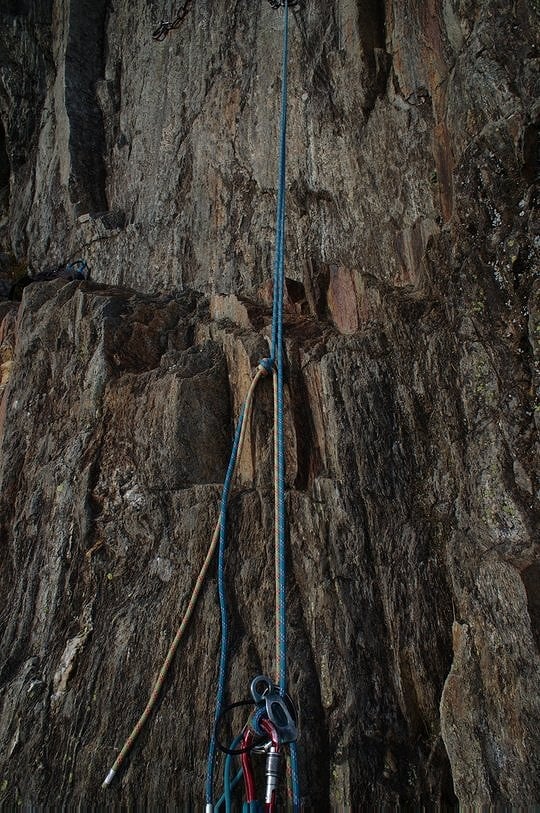
Stand out from the wall when pulling down ropes
When pulling down the ropes the further out from the face you stand the better. By standing out from the wall the knot is pulled through the air instead of against the cliff, meaning that it cannot get caught on anything. As the rope and knot is travelling through the air there is also less friction in play, making it easier to pull. This only works when at the bottom of a route so that you can walk out across the ground, or when you are on a less steeply angled snow slope in the middle of a route. Bear in mind the usual considerations of personal safety from unexpected slips.
Avoid big changes in angle
Avoid abseiling from anchors that are low down and far away from an edge, forming a right-angle in the rope. The added friction from the rope running across the flat ground leading up to the edge can make it impossible to pull down the rope, especially on snow. If the only good anchor found on a ledge is well back from the edge, then extend this with cord so that it hangs over the edge. If this is not possible because the original anchor is too far back, make a short abseil onto the face, and then set up a second anchor here.
How to deal with a stuck rope
So you and your partner find yourselves at the next abseil station or back on the floor, and despite having taken care with the points above your rope has become stuck and you cannot pull it down.
When solving this problem the most important consideration must be your own safety. In everything that you do you must make sure that you are securely attached to the rock or mountain. Always bear in mind what would happen if the stuck rope were to suddenly come free, making sure that you will not shock-load the belay you are currently hanging from.
Free the rope from where you are
Try the following as your first course of action:
If you have just started trying to pull the ropes down then make sure that you are pulling the correct rope, and are not pulling the knot up into the last abseil station.
Resist the temptation to immediately pull on a stuck rope hard, as this may jam it further. Instead, give the ropes a good flick to see if you can dislodge them from wherever they are stuck.
If you still have both ends of the ropes, then pull on the other rope that was previously heading up the cliff. This may unstick the problem, allowing you to flick the ropes free from the constriction before pulling again.
When none of the above works, pull as hard as you can on the rope to try and free it. Have both you and your partner pull at the same time to increase weight. To get more weight again onto the rope put a French prusik onto it and clip this in to the belay loop on your harness, or attach a sling to the prussic loop to stand in. When doing this, remember to make sure that you are in a safe position and cannot fall or shock load your belay if the rope comes free. Be aware that this may dislodge loose rock from above.
Climbing up to free a stuck rope
If a stuck rope cannot be freed from below then you must climb back up to deal with whatever is holding in in place. There are different ways to do this, depending on the way that the ropes have become stuck. It is important to logically think through the process before you begin, making sure that you will at no point be exposed to an unjustifiable level of risk.
Leading up to reach the stuck rope
The easiest way to free a stuck rope is, if possible, to climb back up the rock or ice to wherever the problem is. To make yourself safe whilst doing this. tie into the end of the rope that you have managed to pull down, and be belayed on this as you lead back up to the problem.
The obvious limitation here is that you can only climb back up as far as you have rope available.
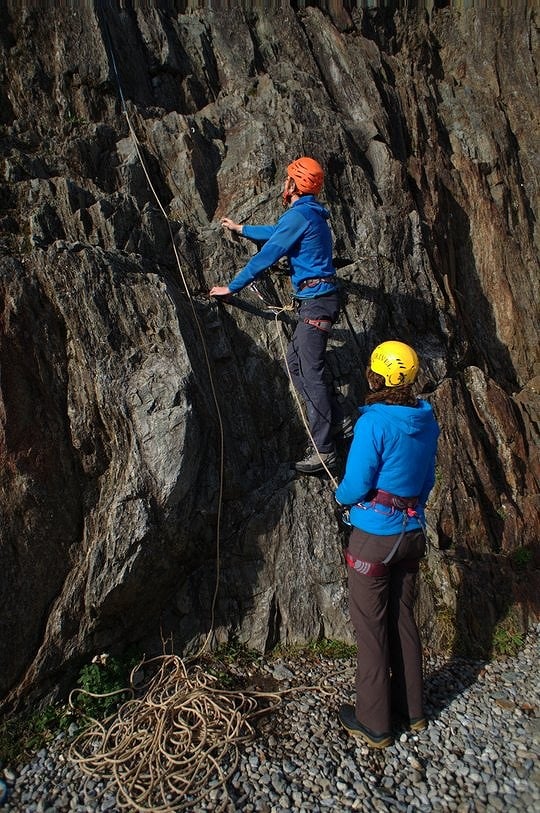
Prusiking up the rope to reach a problem
If it is not possible to climb back up to the problem using the rock or ice next to the rope, the rope itself will have to be climbed using prusiks. The obvious and real danger here is that the rope you are about to commit your weight to could suddenly come free, and it is essential that you make sure you will be safe if this happens. The rope will have taken the weights of both you and your partner pulling hard by this point, but that doesn't mean that it cannot come unstuck, particularly if it is friction holding the ropes in place which will reduce as you climb up and change the direction of the pull. Don't forget to tie a back-up knot in the rope in case your prusiks slip, particularly on iced up ropes.
How to use prusiks to climb a rope is explained in this article and video.
If you have both ends of the ropes…
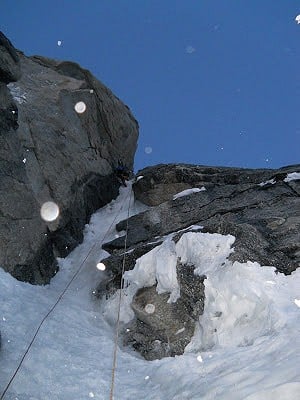
-
The first person prusiks back up the 'pulling' rope
- Before they start, the second person attaches to the other rope, so that it pulls tightly onto their harness.
- Once the person climbing the rope reaches a point where the ropes now move freely they can solve the problem by building an intermediate anchor, re-routing the ropes or extending the original anchors over an edge.
The benefit of tying off the counterbalancing rope to your partner is that they will be able to tell when weight is coming onto them, and hence the point at which you could build an intermediate anchor and pull the ropes through.
The photo in the right shows the author prusiking up a frozen 60m rope to free a stuck knot, 44 hours into a 50 hour trip on Mount Hunter's North Buttress.
Safety Consideration
Are you absolutely confident that the anchor you have abseiled off will take the forces of someone bouncing up and down on it whilst prusiking? If not, place gear on the rope you are ascending, whilst belayed from below, as described lower down in this article. This doesn't remove the need to counterbalance the rope you are ascending.
A cord abseil anchor tied around a tree failed as my partner prusiked back up it, fortunately whilst he was in balance on less steep ground. The consequences could have been extremely serious. This real-life example shows how this needs serious consideration.
If you only have one end of the ropes…
This is the worst case scenario, you only have one strand of rope to hand, with the ropes caught up above you. There are a couple of scenarios where this could happen, with different potential solutions:
You have quite a lot of rope at your belay:
Tie into the end of the rope and get belayed up on this, placing gear to protect yourself, as you prusik up the stuck rope.
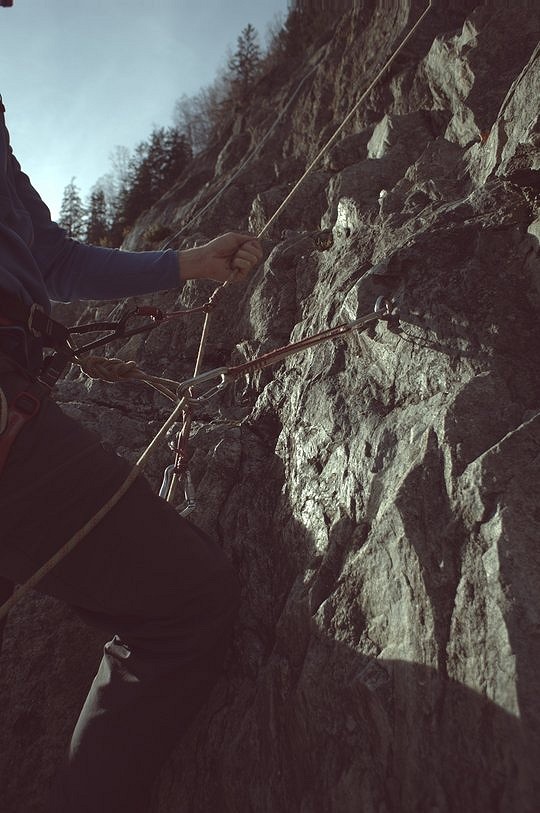
Before committing to do this consider whether or not there are gear placements to protect you when climbing. If you have a lot of rope available, then the safest option could be to abandon the rope stuck above you and continue to make a series of shorter abseils.
You don't have any spare rope to lead back up on, and you don't have the other end of the rope to counterbalance:
This is the stuff that nightmares are made of, and this happening on a big descent in a location where outside help is unlikely could be very serious. I recently heard super-alpinist Colin Haley tell the tale of this situation arising whilst soloing high on Torre Egger in Patagonia, after abseiling down a smoothe overhanging wall of granite. Luckily for him, when bouncing on the stuck rope it pulled through a few mm at a time, costing him hours of effort and trashing one of his ropes but avoiding some fairly risky options.
Solution 1: Await rescue/assistance from other climbers.
Solution 2: Cut whatever rope you have managed to pull down and use this to make short abseils, and to protect sections of downclimbing.
Solution 3:
Prusik back up the stuck rope, whilst placing gear as you go. Your partner belays you on the rope you are prusiking up.
- Your partner puts the stuck rope through their belay device and attentively holds it.
- You tie a clove hitch knot on a screw gate and attach it to your belay loop. This is what will keep you attached to the rope if the rope pulls free and you fall.
- Begin prusiking up the rope, sliding the clove hitch up as you go. Do not unclip the clove hitch and re-tie it, but instead roll the rope through it.
- Place gear and clip this into the rope running between you and your partner, much like when lead climbing.
Solution 4: Start solo down-climbing. Obviously extremely dangerous, a last resort only thinkable if climbing up to retrieve the ropes isn't possible because there's no gear to safeguard the rope coming free, and where outside help is unavailable, e.g. expedition alpine climbing. Think John Christophe Lafaille down climbing the South Face of Annapurna, having watched his partner fall to his death taking the ropes with him.
Cut or abandon your ropes
As a last resort it may be necessary to abandon your rope or ropes, if there is no safe way to climb back up to retrieve them. If you are safely on the ground, and cannot safely get back up to retrieve your stuck ropes, then leave them in place.
About the author:
Will is a climber and skier based in Chamonix, France. He enjoys everything from bouldering to expedition alpine climbing, and recently began the lengthy process of training to become a British Mountain Guide. He posts on UKClimbing as Will_he_fall.


